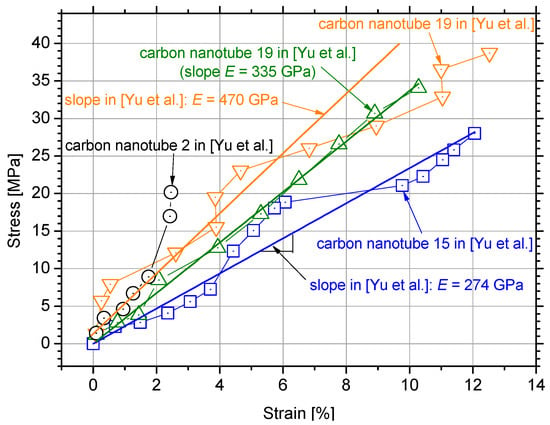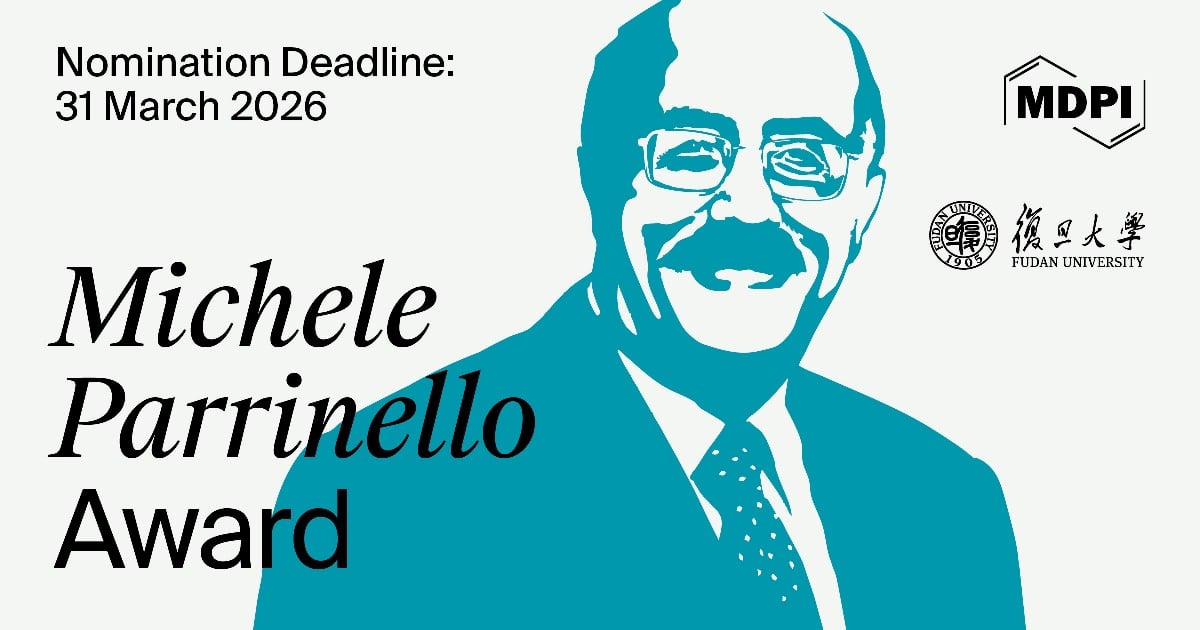Journal Description
Journal of Composites Science
Journal of Composites Science
is an international, peer-reviewed, open access journal on the science and technology of composites, published monthly online by MDPI.
- Open Access— free for readers, with article processing charges (APC) paid by authors or their institutions.
- High Visibility: indexed within Scopus, ESCI (Web of Science), Inspec, CAPlus / SciFinder, and other databases.
- Journal Rank: JCR - Q2 (Materials Science, Composites) / CiteScore - Q1 (Engineering (miscellaneous))
- Rapid Publication: manuscripts are peer-reviewed and a first decision is provided to authors approximately 15.9 days after submission; acceptance to publication is undertaken in 3.9 days (median values for papers published in this journal in the second half of 2025).
- Recognition of Reviewers: reviewers who provide timely, thorough peer-review reports receive vouchers entitling them to a discount on the APC of their next publication in any MDPI journal, in appreciation of the work done.
Impact Factor:
3.7 (2024);
5-Year Impact Factor:
3.9 (2024)
Latest Articles
Finite Element-Based Methodology for the Evaluation of the Flexural Properties of Cement-Based Nanocomposites
J. Compos. Sci. 2026, 10(1), 17; https://doi.org/10.3390/jcs10010017 - 2 Jan 2026
Abstract
The main goal of the present article was to develop a methodology for the calculation of the flexural properties of a cement-based matrix with different multi-walled carbon nanotubes’ (CNTs) volume fraction as a reinforcement at early age. The homogenization tool of the ANSA
[...] Read more.
The main goal of the present article was to develop a methodology for the calculation of the flexural properties of a cement-based matrix with different multi-walled carbon nanotubes’ (CNTs) volume fraction as a reinforcement at early age. The homogenization tool of the ANSA® software package was exploited for the modelling of the inclusion geometries in a cubic matrix and for mesh generation. A Representative Volume Element (RVE) was constructed with either random orientation tensor algorithm or periodic geometry algorithm tools and for different concentrations of the nano-reinforcement. Finite element modelling (FEM) of the pre-cracked specimens for flexural tests followed, and the numerical results were compared against the experimental ones. Different input parameters were considered, including the reinforcement Poisson’s ratio (νCNT) as well as the effective elastic modulus (ECNT) to predict the flexural behaviour of the nano-reinforced matrices. It was found that both parameters play a pivotal role for the numerical simulation and the best simulation results were obtained for CNTs’ effective elastic modulus ECNT = 470 GPa and Poisson’s ratio of νCNT = 0.10 values for the two (2) different investigated concentrations of carbon nanotubes (0.6 and 1.2%, respectively) in the cementitious matrix.
Full article
(This article belongs to the Section Nanocomposites)
►
Show Figures
Open AccessArticle
Degradation of Tensile Properties in CFRCM Composites Under Anodic Polarization: Role of Standardized Electrolyte Solutions
by
Miaochang Zhu, Yawen Zhang, Haorui Chen, Jun Deng and Chaoqun Zeng
J. Compos. Sci. 2026, 10(1), 16; https://doi.org/10.3390/jcs10010016 - 2 Jan 2026
Abstract
This study systematically investigates the tensile property degradation of Carbon Fabric-Reinforced Cementitious Matrix (CFRCM) composites under anodic polarization, explicitly comparing the effects of three standard-required electrolyte environments (NACE/ISO). CFRCM specimens were polarized for 20 days at current densities of 200 and 400 mA/m
[...] Read more.
This study systematically investigates the tensile property degradation of Carbon Fabric-Reinforced Cementitious Matrix (CFRCM) composites under anodic polarization, explicitly comparing the effects of three standard-required electrolyte environments (NACE/ISO). CFRCM specimens were polarized for 20 days at current densities of 200 and 400 mA/m2 in NaCl, NaOH, and simulated concrete pore solutions. Results reveal that anodic polarization significantly reduces peak tensile strength and post-cracking stiffness, with degradation severity dependent on the electrolyte type (NaCl > NaOH > Pore Solution). Crucially, comparative analysis demonstrates that the strength degradation of carbon fiber bundles embedded in the mortar matrix is more pronounced than that of bare bundles. This work provides essential durability data for CFRCM composites for integrated ICCP-Structural Strengthening systems.
Full article
(This article belongs to the Special Issue Composite Materials for Civil Engineering Applications)
►▼
Show Figures
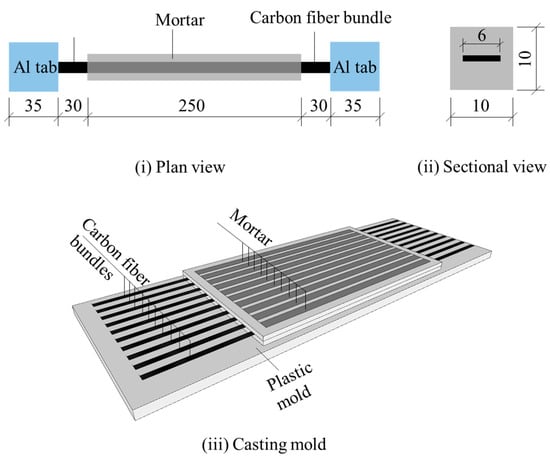
Figure 1
Open AccessArticle
Cross-Property Relations for Continuous Fiber-Reinforced Ceramic Matrix Composites
by
Pu Li, Shouyi Wang, Wei Li, Chunling Zhao, Zhenhua Chen, Jinxin Dai, Shifeng Yuan, Haifeng Zhao and Jian Jiao
J. Compos. Sci. 2026, 10(1), 15; https://doi.org/10.3390/jcs10010015 - 2 Jan 2026
Abstract
Continuous fiber-reinforced ceramic matrix composites (CFRCMCs) are extensively applied in high-temperature fields such as aerospace, energy, and transportation due to their superior mechanical and thermal properties. The explicit and numerical cross-property relations of CFRCMCs are established by integrating a generalized self-consistent scheme, effective-medium
[...] Read more.
Continuous fiber-reinforced ceramic matrix composites (CFRCMCs) are extensively applied in high-temperature fields such as aerospace, energy, and transportation due to their superior mechanical and thermal properties. The explicit and numerical cross-property relations of CFRCMCs are established by integrating a generalized self-consistent scheme, effective-medium conduction models, and finite element analysis. The results reveal that CFRCMCs with a fixed fiber–interphase volume ratio exhibit nearly linear cross-property relations. While the random distribution and diameter of fibers have minimal effects on these relations, a decrease in interphase properties causes the cross-property curves to shift downward. The cross-property relation surfaces for CFRCMCs with varying fiber–interphase volume ratios are validated through finite element analysis. In summary, cross-property relations in CFRCMCs facilitate the prediction of challenging-to-measure physical properties from more readily accessible parameters, substantially simplifying material characterization. This methodology not only optimizes experimental workflows but also delivers a rigorous theoretical framework for multiphysics applications, particularly in extreme thermo-mechanical environments where coupled properties are critical to performance.
Full article
(This article belongs to the Special Issue Editorial Board Members’ Collection Series: Modeling and Simulation of Composite Materials)
►▼
Show Figures
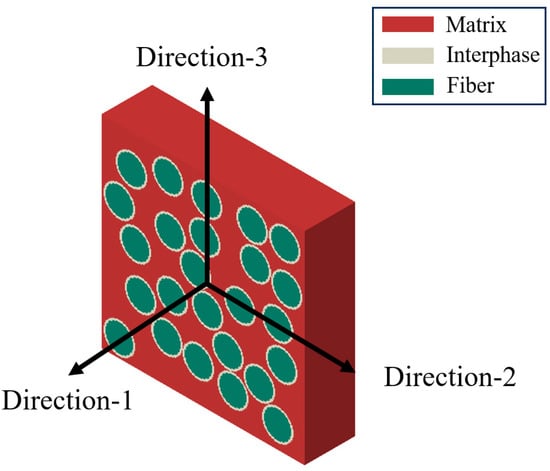
Figure 1
Open AccessArticle
Production and Remanufacturing of Vitrimer Matrix Composite Tubes
by
Alison Kennedy, Carineh Ghafafian and Steven Nutt
J. Compos. Sci. 2026, 10(1), 14; https://doi.org/10.3390/jcs10010014 - 2 Jan 2026
Abstract
Composite tubes were filament-wound and cured using a vitrimer epoxy resin and carbon fiber (CF). The matrix was dissolved under mild conditions, and recovered continuous fiber tows were used to rewind a second-generation tube. Property retention and microstructural quality were evaluated by mechanical
[...] Read more.
Composite tubes were filament-wound and cured using a vitrimer epoxy resin and carbon fiber (CF). The matrix was dissolved under mild conditions, and recovered continuous fiber tows were used to rewind a second-generation tube. Property retention and microstructural quality were evaluated by mechanical tests and examination of polished sections. The vitrimer–matrix composite exhibited a higher short-beam shear strength compared to specimens wound with a traditional epoxy, typical of hydrogen tanks. Single-fiber testing revealed that CFs were not degraded by the recycling process. The remanufactured composite exhibited mechanical properties comparable to those of the first-generation material when normalized to the fiber volume fraction. This work demonstrates a circular manufacturing process that includes full fiber recovery and re-use for producing a second-generation filament-wound article.
Full article
(This article belongs to the Special Issue Composite Materials for Hydrogen Storage)
►▼
Show Figures
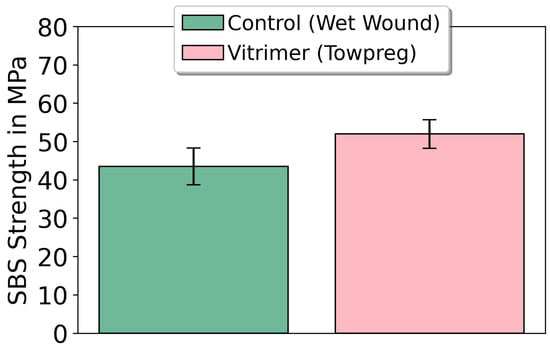
Figure 1
Open AccessArticle
A Temperature-Dependent Visco-Hyperelastic Constitutive Model for Carbon Fiber/Polypropylene Prepreg
by
Haochen Zhu and Mingrui Liu
J. Compos. Sci. 2026, 10(1), 12; https://doi.org/10.3390/jcs10010012 - 1 Jan 2026
Abstract
This study first heat-treats the surface of plain-woven carbon fibers to remove the surface sizing. The treated carbon fibers were then hot-pressed with polypropylene films to produce a carbon fiber/polypropylene prepreg. The resulting prepreg was subjected to uniaxial and off-axis tensile tests, providing
[...] Read more.
This study first heat-treats the surface of plain-woven carbon fibers to remove the surface sizing. The treated carbon fibers were then hot-pressed with polypropylene films to produce a carbon fiber/polypropylene prepreg. The resulting prepreg was subjected to uniaxial and off-axis tensile tests, providing fundamental data for constructing a constitute model for the carbon fiber/polypropylene prepreg. The relative error between the model predictions and experimental data is maintained within ±10%. Based on the experimental results, a temperature-dependent viscoelastic–hyperelastic constitutive model for carbon fiber/polypropylene is proposed. This model decomposes the unit volume strain energy function into four components: matrix isochoric deformation energy, fiber tensile strain energy, fiber–fiber shear strain energy, and fiber-matrix shear strain energy. The matrix energy is strain rate-dependent, exhibiting viscoelastic mechanical behavior. The material parameters of the constitutive model were identified by fitting the experimental data. The model was implemented in MATLABR2024a, and off-axis tensile tests were performed at temperatures ranging from 423 K to 453 K. Numerical simulations were compared with experimental results to validate the model. This work provides guidance for the development and validation of constitutive models for thermoplastic polypropylene prepregs.
Full article
(This article belongs to the Topic Advanced Composites Manufacturing and Plastics Processing, 2nd Volume)
►▼
Show Figures

Figure 1
Open AccessArticle
Improvement of Cyclic Stability of High-Capacity Lithium-Ion Battery Si/C Composite Anode Through Cu Current Collector Perforation
by
Shakhboz Sh. Isokjanov, Ainur B. Gilmanov, Yulia S. Vlasova, Alena I. Komayko, Olesia M. Karakulina and Valeriy V. Krivetskiy
J. Compos. Sci. 2026, 10(1), 11; https://doi.org/10.3390/jcs10010011 - 1 Jan 2026
Abstract
The adoption of silicon-graphite composites as anode materials for the next generation of lithium-ion batteries with enhanced specific capacity requires complex technological efforts in order to mitigate the problem of the quick performance fading of electrodes due to the mechanical degradation of materials.
[...] Read more.
The adoption of silicon-graphite composites as anode materials for the next generation of lithium-ion batteries with enhanced specific capacity requires complex technological efforts in order to mitigate the problem of the quick performance fading of electrodes due to the mechanical degradation of materials. The matter is currently being addressed in terms of electrolyte components, polymer binders, materials structure and morphology itself, as well as current collector design, which differ greatly in cost and scalability. The present work describes the efficacy of Cu foil perforation—a simple, low-cost, and easily scalable approach—as a means of Si/C composite anode performance stabilization during extensive charge-discharge cycling. The NMC||Si/C pouch-type full cells demonstrated over 90% of initial capacity retention after 100 charge-discharge cycles in the case of a 250 µm perforated Cu foil used as a current collector, compared to only 60% capacity left in the same conditions for plain Cu foil as an anode. The obtained result is related to the prevention of anode material delamination off the foil surface as a result of silicon expansion and contraction, which is achieved through the formation inter-penetrating metal-composite structure and the presence of “stitches”, connecting and holding both sides of the electrode tightly attached to the current collector.
Full article
(This article belongs to the Section Composites Applications)
►▼
Show Figures

Figure 1
Open AccessArticle
Effect of Paraffin Microcapsule and Carbon Nanotube Content on the Thermal Behavior of Thermoplastic Polyurethane Nanocomposites with Thermal Energy Storage Capability
by
Daniele Rigotti, Andrea Dorigato and Alessandro Pegoretti
J. Compos. Sci. 2026, 10(1), 10; https://doi.org/10.3390/jcs10010010 - 1 Jan 2026
Abstract
The development of multifunctional polymer composites capable of both heat conduction and latent heat storage is of great interest for advanced thermal management applications. In this work, thermoplastic polyurethane (TPU) nanocomposites containing microencapsulated paraffin-based phase change materials (PCMs) and multi-walled carbon nanotubes (MWCNTs)
[...] Read more.
The development of multifunctional polymer composites capable of both heat conduction and latent heat storage is of great interest for advanced thermal management applications. In this work, thermoplastic polyurethane (TPU) nanocomposites containing microencapsulated paraffin-based phase change materials (PCMs) and multi-walled carbon nanotubes (MWCNTs) were systematically investigated. The microstructure, thermal stability, specific heat capacity, thermal diffusivity and conductivity of these composites were analyzed as a function of the PCM and MWCNTs content. SEM observations revealed the homogeneous dispersion of PCM microcapsules and the presence of localized MWCNT aggregates in PCM-rich domains. Thermal diffusivity measurements indicated a monotonic decrease with increasing temperature for all compositions, from 0.097 mm2·s−1 at 5 °C to 0.091 mm2·s−1 at 25 °C for neat TPU, and from 0.186 mm2·s−1 to 0.173 mm2·s−1 for TPU with 5 vol.% MWCNTs. Distinct non-linear behavior was observed around 25 °C, i.e., in correspondence to the paraffin melting, where the apparent diffusivity temporarily decreased due to latent heat absorption. The trend of the thermal conductivity (λ) was determined by the competing effects of PCM and MWCNTs: PCM addition reduced λ at 25 °C from 0.162 W·m−1·K−1 (neat TPU) to 0.128 W·m−1·K−1 at 30 vol.% PCM, whereas the incorporation of 5 vol.% of MWCNTs increased λ up to 0.309 W·m−1·K−1. In PCM-containing nanocomposites, MWCNT networks efficiently bridged the polymer–microcapsule interfaces, creating continuous conductive pathways that mitigated the insulating effect of the encapsulated paraffin and ensured stable heat transfer even across the solid–liquid transition. A one-dimensional transient heat-transfer model confirmed that increasing the matrix thermal conductivity accelerates the melting of the PCM, improving the dynamic thermal buffering capacity of these materials. Therefore, these results underlined the potential of TPU/MWCNT/PCM composites as versatile materials for applications requiring both rapid heat dissipation and effective thermal management.
Full article
(This article belongs to the Special Issue Feature Papers in Journal of Composites Science in 2025)
►▼
Show Figures

Figure 1
Open AccessArticle
Interactive Influence of Recycled Concrete Aggregate and Recycled Steel Fibers on the Fresh and Hardened Performance of Eco-Efficient Fiber-Reinforced Self-Compacting Concrete
by
Ahmed Redha Abdul-Rahman, Khaleel Hasan Younis and Bahman Omar Taha
J. Compos. Sci. 2026, 10(1), 9; https://doi.org/10.3390/jcs10010009 - 1 Jan 2026
Abstract
This study investigates the synergistic influence of recycled concrete aggregate (RCA) and recycled steel fibers (RSF) on the fresh and hardened performance of eco-efficient fiber-reinforced self-compacting concrete (SCC). Twelve C30/37.5 mixtures were produced using demolition waste as coarse RCA at replacement levels of
[...] Read more.
This study investigates the synergistic influence of recycled concrete aggregate (RCA) and recycled steel fibers (RSF) on the fresh and hardened performance of eco-efficient fiber-reinforced self-compacting concrete (SCC). Twelve C30/37.5 mixtures were produced using demolition waste as coarse RCA at replacement levels of 25, 50, 75, and 100% by mass, combined with RSF recovered from scrap tires at volume fractions of 0.25, 0.50, and 0.75%. Fresh properties were assessed in accordance with EFNARC guidelines using slump-flow (T500), V-funnel, L-box, and J-ring tests, while hardened performance was evaluated through compressive, splitting tensile, and flexural strengths at 28 days, together with density and ultrasonic pulse velocity (UPV). Increasing RCA and RSF contents reduced workability, reflected in lower slump-flow diameters and higher T500 and V-funnel times, although most mixtures maintained satisfactory self-compacting behaviour. Compressive strength decreased with RCA content and, to a lesser extent, with higher RSF, with a maximum reduction of about 39% at 100% RCA relative to the control mix, yet values remained structurally acceptable. In contrast, RSF markedly enhanced tensile and flexural responses: at 25% RCA, 0.75% RSF increased splitting tensile and flexural strengths by approximately 41% and 29%, respectively, compared with the corresponding fiber-free mix. RCA reduced density and UPV by about 10–14%, but these reductions were partially mitigated by RSF addition. Overall, the results demonstrate that SCC with moderate RCA (25–50%) and RSF (0.50–0.75%) can achieve a favourable balance between rheological performance and enhanced tensile and flexural behaviour, offering a viable composite solution for sustainable structural applications.
Full article
(This article belongs to the Section Composites Applications)
►▼
Show Figures

Figure 1
Open AccessArticle
Design of an Additively Manufactured Torsion Bushing with a Gyroid Core Topology
by
Dragoş Alexandru Apostol, Dan Mihai Constantinescu, Ștefan Sorohan and Alexandru Vasile
J. Compos. Sci. 2026, 10(1), 8; https://doi.org/10.3390/jcs10010008 - 1 Jan 2026
Abstract
This study examines the torsional behavior of an additively manufactured bushing featuring a unique topology, which includes a flexible gyroid core and rigid inner and outer sleeves. The bushing is designed and fabricated using two materials: thermoplastic polyurethane (TPU) and polylactic acid (PLA),
[...] Read more.
This study examines the torsional behavior of an additively manufactured bushing featuring a unique topology, which includes a flexible gyroid core and rigid inner and outer sleeves. The bushing is designed and fabricated using two materials: thermoplastic polyurethane (TPU) and polylactic acid (PLA), which are interpenetrated in successive layers throughout the bushing’s thickness. First, tensile mechanical tests are conducted on both materials with different infill patterns. The 45/135 infill proves to be the most suitable, providing good stiffness, strength, ductility, and data reproducibility. Additionally, the effectiveness of the interlocking created between the two materials through the printing process is evaluated by testing different overlap lengths. With an overlap of 2 mm, the extrusion process remains unaffected, minimizing voids and defects while ensuring strong interlayer bonding. Next, the designed bushing is subjected to torsional loading under both single and repetitive angular rotations, and its response is measured in terms of torque. The aim of this study is to evaluate the suitability of TPU and PLA materials for developing a design intended for dynamic mechanical environments, serving as a proof of concept. The quasi-static results indicate the presence of local damages and a viscoelastic response of the bushing during twisting, while also demonstrating its strong ability to withstand significant angles of rotation. Quasi-static results indicate local damage and the bushing’s viscoelastic response during twisting, as well as its ability to withstand significant angles of rotation.
Full article
(This article belongs to the Topic Advances in Rubbers, Elastomers and Resins for Leading Edge Technologies)
►▼
Show Figures

Figure 1
Open AccessArticle
An Energetic Analysis of Apparent Hardening and Ductility in FRP Plate Debonding
by
Nefeli Mitsopoulou and Marinos Kattis
J. Compos. Sci. 2026, 10(1), 7; https://doi.org/10.3390/jcs10010007 - 1 Jan 2026
Abstract
We investigate the progressive debonding of FRP reinforcements using an analytical framework based on fracture mechanics and a bilinear softening cohesive law. This study focuses on the energetic analysis of the “apparent hardening” phase observed in the force–slip (
We investigate the progressive debonding of FRP reinforcements using an analytical framework based on fracture mechanics and a bilinear softening cohesive law. This study focuses on the energetic analysis of the “apparent hardening” phase observed in the force–slip (
(This article belongs to the Special Issue Polymer Composites and Fibers, 3rd Edition)
►▼
Show Figures
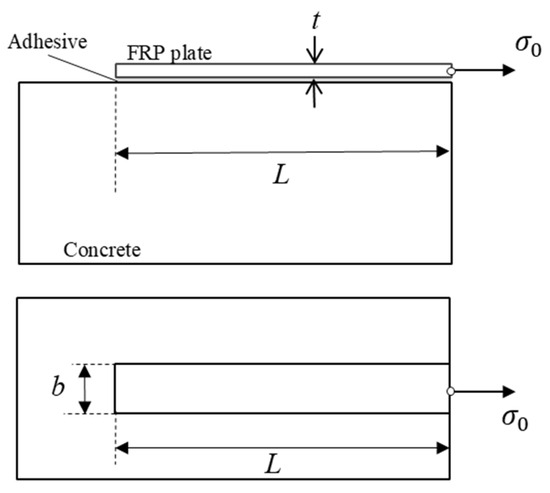
Figure 1
Open AccessArticle
Structural Adhesive Bonding of Vacuum-Infused Acrylic-Based Thermoplastic Fibre-Reinforced Laminates
by
Nils Xavier Bohlmann, Pedro Henrique Evangelista Fernandes, Morten Voß, Sebastian Veller, Christof Nagel, Katharina Arnaut and Vinicius Carrillo Beber
J. Compos. Sci. 2026, 10(1), 6; https://doi.org/10.3390/jcs10010006 - 1 Jan 2026
Abstract
Driven by regulatory and environmental demands, composite structures must combine high structural performance, recyclability, and resource efficiency. Here, an investigation on the structural adhesive bonding of glass-fibre-reinforced thermoplastic Elium© composite laminates is undertaken. Substrates are manufactured using vacuum infusion. Evaluation is performed on
[...] Read more.
Driven by regulatory and environmental demands, composite structures must combine high structural performance, recyclability, and resource efficiency. Here, an investigation on the structural adhesive bonding of glass-fibre-reinforced thermoplastic Elium© composite laminates is undertaken. Substrates are manufactured using vacuum infusion. Evaluation is performed on the following three commercial two-component adhesives cured at RT: an epoxy (EP), a polyurethane (PU), and an acrylate system (AC). Based on Dynamic Mechanical Analysis, the glass transition temperatures of the EP, PU, and AC adhesives are 56.5, 102.9, and 111.9 °C, respectively. The AC adhesive exhibits the highest shear strength and displacement at failure, reflecting a superior load-bearing capacity. Fractographic analysis further supports these findings: AC joints show a mixed substrate/cohesive failure mode, while EP samples fail exclusively by adhesion failure and PU samples predominantly by a mixture of special cohesion, adhesion and substrate failure. Regarding processing, the EP samples show the highest pot life, followed by PU and then AC. Nonetheless, the pot life of the AC adhesive does not limit its range of application.. The results highlight the advantages of adhesive bonding of Elium© in enabling lightweight and more circular composites. RT-cured adhesives eliminate the need for drilling and energy-intensive thermal curing, allowing design flexibility and reductions in CO2 footprint within composite production.
Full article
(This article belongs to the Special Issue Composites: A Sustainable Material Solution, 2nd Edition)
►▼
Show Figures

Graphical abstract
Open AccessArticle
Flexural Performance of Pre-Cracked UHPC with Varying Fiber Contents and Fiber Types Exposed to Freeze–Thaw Cycles
by
Dip Banik, Omar Yadak and Royce Floyd
J. Compos. Sci. 2026, 10(1), 5; https://doi.org/10.3390/jcs10010005 - 1 Jan 2026
Abstract
Ultra-high-performance concrete (UHPC) is an advanced cementitious composite material with high durability and the strength properties exceeding those of conventional concrete. This paper presents the results of experimental testing assessing the freeze–thaw durability of UHPC specimens with varying fiber types (13 mm straight
[...] Read more.
Ultra-high-performance concrete (UHPC) is an advanced cementitious composite material with high durability and the strength properties exceeding those of conventional concrete. This paper presents the results of experimental testing assessing the freeze–thaw durability of UHPC specimens with varying fiber types (13 mm straight microfibers and 30 mm hooked-end fibers) and fiber percentages, as well as pre-existing cracks. The performance of all specimens was evaluated by measuring resonant frequency at intervals during testing and residual flexural strength after the completion of 350 freeze–thaw cycles. All specimens showed no degradation of resonant frequency over time. However, the pre-cracked specimens showed an increase in resonant frequency over the course of testing. The uncracked straight fibers specimens exposed to freeze–thaw cycles had the highest flexural strength, but the flexural resistance of the pre-cracked straight fibers specimens increased compared to the control specimens after 350 freeze–thaw cycles. The pre-cracked hooked fiber specimens showed higher first cracking strength and similar ultimate strength to the uncracked specimens after freeze–thaw exposure.
Full article
(This article belongs to the Special Issue Environmental Degradation of Composites: Microscopic Characterization and Analysis)
►▼
Show Figures
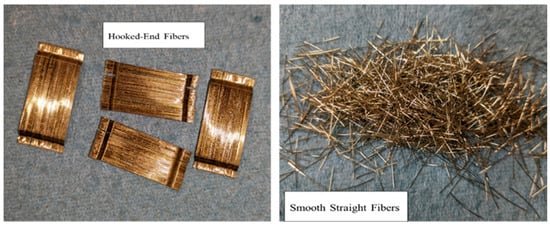
Figure 1
Open AccessArticle
Hybrid Laminate Design for Forming and Molding of D-Shaped Composite Beams
by
Swayam Shree and Krishnamurthy Jayaraman
J. Compos. Sci. 2026, 10(1), 4; https://doi.org/10.3390/jcs10010004 - 1 Jan 2026
Abstract
Closed-section composite structures with corners present significant challenges during forming and molding for achieving the desired thickness distribution over the profile. The experimental investigation in the present work was designed to compare laminates constructed entirely from twill-weave carbon fabric prepregs with different hybrid
[...] Read more.
Closed-section composite structures with corners present significant challenges during forming and molding for achieving the desired thickness distribution over the profile. The experimental investigation in the present work was designed to compare laminates constructed entirely from twill-weave carbon fabric prepregs with different hybrid laminates constructed by combining unidirectional (UD) carbon fiber prepregs around the flat and twill-weave fabric prepregs around the curved section. Although the UD fiber prepregs were found to be more compressible than the twill-weave prepregs, the desired thickness distribution (to within 2% of design geometry), along with the proper level of consolidation, was obtained only with the hybrid construction that had an equal number of UD plies around the flat and twill-weave plies around the curved section. In contrast, the thickness distribution obtained with the all-twill prepreg laminate deviated from the design geometry by 5.4%. Forming simulations incorporating experimentally derived compaction behavior of different plies were used to predict the local compaction, tool–ply contact pressures, and thickness profile of the molded part. The simulation results for thickness profiles showed similar trends to those observed in experiments.
Full article
(This article belongs to the Section Composites Modelling and Characterization)
►▼
Show Figures

Figure 1
Open AccessArticle
A New Family of Minimal Surface-Based Lattice Structures for Material Budget Reduction
by
Francesco Fransesini and Pier Paolo Valentini
J. Compos. Sci. 2026, 10(1), 3; https://doi.org/10.3390/jcs10010003 - 31 Dec 2025
Abstract
This article aims to describe a novel workflow designed for generating a new family of minimal surface-based lattice structures with improved performance in terms of material budget compared to the well-known cells like Gyroid and Schwartz. The implemented method is based on the
[...] Read more.
This article aims to describe a novel workflow designed for generating a new family of minimal surface-based lattice structures with improved performance in terms of material budget compared to the well-known cells like Gyroid and Schwartz. The implemented method is based on the iterative resolution of a dynamic model, where proper forces are applied to generate minimal surface lattices, considering the boundary conditions and the constraint configurations. The novelty of the approach is given by the ability to create a minimal surface without resolving the partial differential equation and without knowing the exact minimal surface generative function. The starting geometry used for the lattice generation is the hypercube, parametrized to create different lattice configurations. Creating five different starting geometries and two constraint configurations, ten different lattice cells were created. For the comparison, a representative parameter of the material budget has been introduced and used to define the two best cells. The material budget is crucial for particle accelerator components, sensors, and detectors. These cells have been compared with Gyroid and Schwartz of the same thickness and bounding box, highlighting improvements of a factor of 2.3 and 1.7, respectively, in terms of material budget. The same cells have also been 3D-printed and tested under compression, and the obtained force–displacement curves were compared with those from a finite element analysis, demonstrating good agreement in the elastic region.
Full article
(This article belongs to the Special Issue Lattice Structures)
►▼
Show Figures

Figure 1
Open AccessArticle
FiberGAN: A Conditional GAN-Based Model for Small-Sample Prediction of Stress–Strain Fields in Composites
by
Lidong Wan, Haitao Fan, Xiuhua Chen and Fan Guo
J. Compos. Sci. 2026, 10(1), 2; https://doi.org/10.3390/jcs10010002 - 30 Dec 2025
Abstract
Accurate prediction of the stress–strain fields in fiber-reinforced composites is crucial for performance analysis and structural design. However, due to their complex microstructures, traditional finite element analysis (FEA) entails a very high computational cost. Therefore, this study proposes a conditional generative adversarial network
[...] Read more.
Accurate prediction of the stress–strain fields in fiber-reinforced composites is crucial for performance analysis and structural design. However, due to their complex microstructures, traditional finite element analysis (FEA) entails a very high computational cost. Therefore, this study proposes a conditional generative adversarial network (cGAN) framework, named FiberGAN, to enable rapid prediction of the microscopic stress–strain fields in fiber-reinforced composites. The method employs an adaptive representative volume element (RVE) generation algorithm to construct random fiber arrangements with fiber volume fractions ranging from 30% to 50% and uses FEA to obtain the corresponding stress and strain fields as training data. A U-Net generator, combined with a PatchGAN discriminator, captures both global distribution patterns and fine local details. Under tensile and shear loading conditions, the R2 values of FiberGAN predictions range from 0.96 to 0.99, while the structural similarity index (SSIM) values range from 0.95 to 0.99. The error maps show that prediction residuals are mainly concentrated in high-gradient regions with small magnitudes. These results demonstrate that the proposed deep learning model can successfully predict stress–strain field distributions for different fiber volume fractions under various loading conditions.
Full article
(This article belongs to the Section Fiber Composites)
►▼
Show Figures

Figure 1
Open AccessCommunication
Tribological and Low Temperature Behavior of ZTA Composites with Graphene Oxide Addition Reinforced with Ductile Particles
by
Pavel Peretyagin, Oleg Yanushevich, Natella Krikheli, Yuri Pristinskiy, Nestor Washington Solis Pinargote, Anton Smirnov and Nikita Grigoriev
J. Compos. Sci. 2026, 10(1), 1; https://doi.org/10.3390/jcs10010001 - 22 Dec 2025
Abstract
The objective of this research was to assess the tribological performance and the capacity to withstand low-temperature degradation of alumina-zirconia-tantalum (ZTA) ceramic-metal composites, modified with 0.5 vol.% graphene oxide (GO) under ball (alumina) on disk dry sliding conditions. The studied ceramic and ceramic-metal
[...] Read more.
The objective of this research was to assess the tribological performance and the capacity to withstand low-temperature degradation of alumina-zirconia-tantalum (ZTA) ceramic-metal composites, modified with 0.5 vol.% graphene oxide (GO) under ball (alumina) on disk dry sliding conditions. The studied ceramic and ceramic-metal composites reinforced with 20 vol.% of tantalum particles were prepared using a colloidal mixing and sintered at a temperature of 1500 °C using a spark plasma sintering technique. In contrast to ZTA ceramic, the wear performance of composites with metal particles and graphene oxide was significantly improved, regardless of the chosen load (10 N and 40 N). The results showed an improvement in the friction coefficient of about 20% and 15% at low and high load, respectively. The wear rate was reduced by 2 and 7 times at 10 N and 40 N, respectively. Raman and energy dispersive spectroscopy confirmed that ZTA-Ta-rGO composites exhibited superior wear resistance primarily because a protective tribolayer formed on their surfaces during wear. This layer effectively lubricated the surfaces, leading to a decrease in both friction and the rate of material loss. Furthermore, these composites exhibited excellent resistance to low-temperature degradation. The results obtained will serve as a starting point for future biomedical testing directions, opening up new perspectives for the use of these materials in biomedicine.
Full article
(This article belongs to the Section Composites Manufacturing and Processing)
►▼
Show Figures

Figure 1
Open AccessArticle
Supplementary Cementitious Material from Epsom Salt Production Waste
by
Rimvydas Kaminskas, Arijus Zuzevicius and Irmantas Barauskas
J. Compos. Sci. 2025, 9(12), 708; https://doi.org/10.3390/jcs9120708 - 18 Dec 2025
Abstract
In this study, the potential use of Epsom salt production waste as a supplementary cementitious material was investigated. This acidic waste was neutralized with lime milk and used to replace up to 25 wt.% of Portland cement. The following research methods were employed:
[...] Read more.
In this study, the potential use of Epsom salt production waste as a supplementary cementitious material was investigated. This acidic waste was neutralized with lime milk and used to replace up to 25 wt.% of Portland cement. The following research methods were employed: XRD, XRF, SEM, DSC-TG, and isothermal calorimetry. The waste neutralization process was found to proceed consistently, producing a neutral material (pH = 7.5) composed of amorphous silicon compounds with a negligible impurity of crystalline antigorite. Consequently, this material exhibits very high pozzolanic activity. The neutralized Epsom salt production waste accelerates the early hydration of Portland cement and promotes an intense pozzolanic reaction. This new material is a highly effective supplementary cementitious material, capable of replacing up to 25 wt.% of Portland cement without reducing its strength class.
Full article
(This article belongs to the Section Composites Applications)
►▼
Show Figures

Figure 1
Open AccessArticle
Influence of Shungite from the Bakyrchik Deposit on the Properties of Rubber Composites Based on a Blend of Non-Polar Diene Rubbers
by
Kanat Beknazarov, Abdirakym Nakyp, Elena Cherezova, Yulia Karaseva, Azat Khasanov, Wojciech Ignaczak, Rustam Tokpayev and Mikhail Nauryzbayev
J. Compos. Sci. 2025, 9(12), 707; https://doi.org/10.3390/jcs9120707 - 18 Dec 2025
Abstract
The study investigates the influence of a hybrid filler system based on carbon black, silica (SiO2) and shungite from the Bakyrchik deposit on the curing behavior of rubber compounds as well as on the physical–mechanical properties and thermal stability of vulcanizates
[...] Read more.
The study investigates the influence of a hybrid filler system based on carbon black, silica (SiO2) and shungite from the Bakyrchik deposit on the curing behavior of rubber compounds as well as on the physical–mechanical properties and thermal stability of vulcanizates based on a blend of butadiene-alpha-methylstyrene and isoprene rubbers. The morphology and elemental composition of shungite were examined using SEM-EDS analysis. Thermogravimetric analysis of shungite was also performed. The introduction of shungite led to a decrease in Mooney viscosity and an increase in scorch time. Rubber composites containing 10–20 phr (parts per hundred rubber) of shungite exhibited a satisfactory balance between the processing properties of the rubber compounds and the physical–mechanical properties of the vulcanizates (tensile strength, elongation at break, and rebound resiliency), which makes them promising for practical application. When 10 phr of shungite was added, the tensile strength of the rubber composites after thermal aging remained at the level of the control sample, while the changes in elongation at break, rebound resilience, and hardness were less pronounced than in the control.
Full article
(This article belongs to the Special Issue Rubber-Based Composites: Challenges in Reusing Waste and Nanostructures as Fillers)
►▼
Show Figures

Figure 1
Open AccessArticle
Antibacterial and Non-Toxic to Mammalian Cell Composite Material Based on Polymethyl-Methacrylate-like Resin Containing Grain-Shaped Copper Oxide Nanoparticles
by
Fatikh M. Yanbaev, Dmitriy N. Ignatenko, Anastasiia V. Shabalina, Ilya V. Baimler, Dmitry E. Burmistrov, Maxim E. Astashev, Vasily N. Lednev, Alena A. Nastulyavichus, Roman Yu. Pishchalnikov, Ruslan M. Sarimov, Alexander V. Simakin and Sergey V. Gudkov
J. Compos. Sci. 2025, 9(12), 706; https://doi.org/10.3390/jcs9120706 - 18 Dec 2025
Abstract
Granular copper oxide nanoparticles (CopOx NPs), synthesized via laser ablation (100 nm, ζ-potential +30 mV), were introduced into photolithographic polymethyl methacrylate (PMMA) resin at concentrations of 0.001–0.1%. The resulting composite material enables the fabrication of high-resolution (up to 50 μm) parts with a
[...] Read more.
Granular copper oxide nanoparticles (CopOx NPs), synthesized via laser ablation (100 nm, ζ-potential +30 mV), were introduced into photolithographic polymethyl methacrylate (PMMA) resin at concentrations of 0.001–0.1%. The resulting composite material enables the fabrication of high-resolution (up to 50 μm) parts with a high degree of surface quality after polishing using the MSLA method. CopOx NPs increased the degree of resin polymerization (decrease by almost 4× in unpolymerized components at 0.1% CopOx NPs) and induced the in situ formation of self-organized periodic structures visible under a modulation interference microscope. The composite samples exhibit pronounced oxidative activity: they intensify the generation of hydrogen peroxide and hydroxyl radicals and cause the oxidative modification of biomolecules (formation of 8-oxoguanine in DNA and long-lived reactive forms of proteins). A key property of the materials is their selective biological activity. While lacking cytotoxicity for human fibroblasts, they exhibit a strong antibacterial effect against E. coli, leading to cell death within 24 h. Thus, the developed composite photolithographic resin combines improved technological characteristics (high printing resolution, degree of polymerization) with functional properties (selective antibacterial activity) and holds promise for application in biomedicine, as well as in the food and agricultural industries.
Full article
(This article belongs to the Special Issue Advances in Sustainable Composites and Manufacturing Innovations)
►▼
Show Figures

Figure 1
Open AccessArticle
Performance of Rubber Seals for Cable-Based Tsunameter with Varying Ethylene Propylene Diene Monomer and Filler Content
by
Riastuti Fidyaningsih, Dewi Kusuma Arti, Herri Susanto, Ade Sholeh Hidayat, Mahendra Anggaravidya, Akhmad Amry, Tika Mustika, Muslim Efendi Harahap, Vian Marantha Haryanto and Mochammad Dachyar Effendi
J. Compos. Sci. 2025, 9(12), 705; https://doi.org/10.3390/jcs9120705 - 17 Dec 2025
Abstract
This study evaluates the performance of ethylene propylene diene monomer (EPDM) composites for rubber sealing applications in a cable-based tsunami system. Rubber composites were prepared using EPDM rubber with varying monomer and filler content to determine the most suitable composite. Mechanical characterization reveals
[...] Read more.
This study evaluates the performance of ethylene propylene diene monomer (EPDM) composites for rubber sealing applications in a cable-based tsunami system. Rubber composites were prepared using EPDM rubber with varying monomer and filler content to determine the most suitable composite. Mechanical characterization reveals that the composition of EPDM and the amount of filler loading influence the mechanical properties. Dynamic mechanical analysis shows that ethylene and 5-ethylene-2-norbornene (ENB) content influence the glass transition and viscoelastic behavior of the composite. Thermal analysis of rubber composites using EPDM containing 70% ethylene and 5% ENB indicates no change in thermal stability due to prolonged immersion in seawater. Visual inspection using a microscope reveals no cracks on the surface of the rubber seal after the pressure chamber test for rubber composites utilizing EPDM with 70% ethylene and 5% ENB. It was shown that EPDM containing 70% ethylene and 5% ENB, with optimal reinforcement with 80 phr carbon black, exhibits the best performance for rubber sealing applications in subsea environments.
Full article
(This article belongs to the Section Composites Applications)
►▼
Show Figures

Figure 1

Journal Menu
► ▼ Journal Menu-
- J. Compos. Sci. Home
- Aims & Scope
- Editorial Board
- Reviewer Board
- Topical Advisory Panel
- Instructions for Authors
- Special Issues
- Topics
- Sections & Collections
- Article Processing Charge
- Indexing & Archiving
- Editor’s Choice Articles
- Most Cited & Viewed
- Journal Statistics
- Journal History
- Journal Awards
- Conferences
- Editorial Office
Journal Browser
► ▼ Journal BrowserHighly Accessed Articles
Latest Books
E-Mail Alert
News
Topics
Topic in
Fibers, J. Compos. Sci., Materials, Polymers, Applied Mechanics
Advances in Fiber–Matrix Interface: Cohesion Enhancement, Characterization and Modeling of Interfacial Debonding
Topic Editors: Quentin Bourgogne, Hamid Zahrouni, Hubert ChapuisDeadline: 28 February 2026
Topic in
Materials, Ceramics, J. Compos. Sci.
New Advances in High-Performance Structural Ceramics and Their Composites
Topic Editors: Amparo Borrell, Rut Benavente, Rujie HeDeadline: 31 March 2026
Topic in
Alloys, Applied Mechanics, Crystals, J. Compos. Sci., Powders, Nanomaterials
Multiscale Characterization, Mechanical Behavior and Computational Simulation of Bulk Materials, Metallic Powders and/or Nanoparticles
Topic Editors: Xiangnan Pan, Qing Peng, Hui Qi, Raj DasDeadline: 30 June 2026
Topic in
Fibers, J. Compos. Sci., JMMP, Materials, Polymers, Recycling
Advanced Composites Manufacturing and Plastics Processing, 2nd Volume
Topic Editors: Patricia Krawczak, Ludwig Cardon, Frederik DesplentereDeadline: 1 September 2026

Conferences
Special Issues
Special Issue in
J. Compos. Sci.
Trends and Challenges in Developing and Processing Composite Materials
Guest Editor: Heitor Luiz Ornaghi JúniorDeadline: 15 January 2026
Special Issue in
J. Compos. Sci.
Composite Materials for Civil Engineering Applications
Guest Editors: Yanshuai Wang, Dong Guo, Jun He, Bai ZhangDeadline: 20 January 2026
Special Issue in
J. Compos. Sci.
Innovations of Composite Materials in Prosthetic Dentistry
Guest Editors: Rodolfo Reda, Dario Di NardoDeadline: 30 January 2026
Special Issue in
J. Compos. Sci.
Polymer Composites: Fiber Architecture, Interfacial Engineering, and Processing
Guest Editors: Kristofer Paso, Patrycja Bazan, P. M. VisakhDeadline: 31 January 2026
Topical Collections
Topical Collection in
J. Compos. Sci.
Editorial Board Members’ Collection Series: Fibre Composite Materials
Collection Editors: Hom Nath Dhakal, Mazeyar Parvinzadeh Gashti, Esfandiar Pakdel


